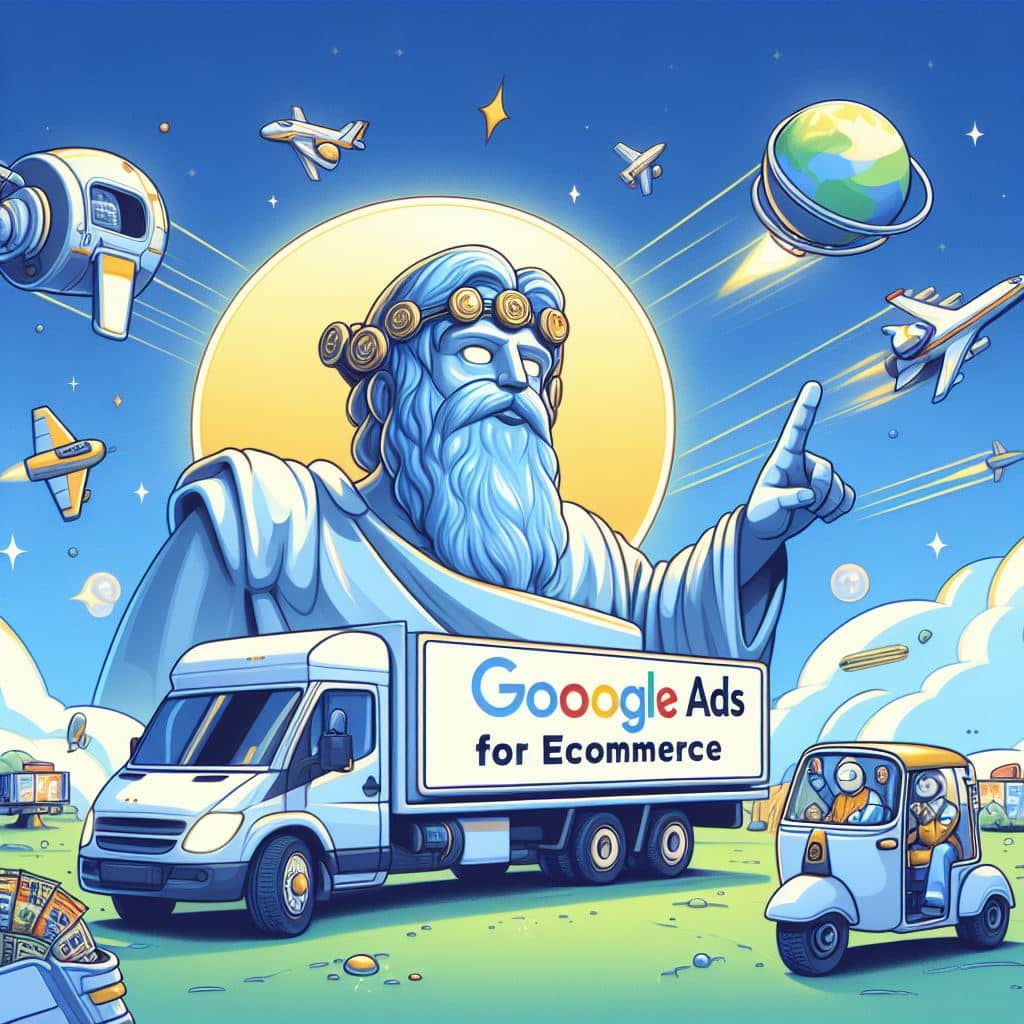How to Do Google Ads for Ecommerce in 2024: A Forward-Thinking Approach.
As we step into 2024, the landscape of digital advertising continues to evolve at a rapid pace, with Google Ads at the forefront of this transformation. In the dynamic world of ecommerce, where staying ahead of the curve is not just an advantage but a necessity, understanding and leveraging Google Ads has become more crucial than ever. This platform, known for its powerful targeting capabilities and expansive reach, is undergoing continuous changes to align with emerging trends and technologies in digital marketing.
The role of Google Ads in the ecommerce sector has significantly expanded, transcending beyond traditional search ads to encompass a variety of formats and strategies tailored to the modern consumer's journey. From shopping ads that showcase products directly in search results to display ads that capture attention across websites, Google Ads has become a versatile tool for ecommerce businesses aiming to connect with their audience effectively.
In 2024, adapting to new trends and technologies in digital advertising is not just about staying competitive; it's about redefining how we connect with customers and drive sales. The integration of AI for smarter targeting, the rise of voice and visual search, and the increasing importance of mobile-first strategies are just a few of the developments reshaping the Google Ads landscape. As ecommerce businesses, embracing these changes and leveraging the advanced capabilities of Google Ads is essential to reach potential customers more effectively and create more personalized, engaging advertising experiences.
In this article, we will delve into the nuances of using Google Ads for ecommerce in 2024, exploring the latest trends, best practices, and strategies to maximize your advertising efforts and drive meaningful results in this ever-evolving digital world.
The Landscape of Google Ads in 2024
As we navigate through 2024, the landscape of Google Ads has undergone significant transformations, adapting to the latest advancements in technology and shifts in online consumer behavior. These changes are not just incremental; they represent a paradigm shift in how ecommerce businesses connect with their audience.
Advancements in Google Ads
One of the most notable advancements in Google Ads is the integration of AI and machine learning. These technologies have revolutionized ad targeting and optimization, enabling businesses to reach their ideal customers more efficiently than ever before. AI algorithms now analyze user data to predict buying behaviors, optimize bids in real-time, and personalize ads based on user preferences and search history.
Another significant change is the rise of voice and visual search capabilities within Google Ads. With the increasing use of voice-activated devices and image search technologies, ads are now being optimized for these platforms, allowing businesses to tap into new segments of the market.
Shifts in Online Consumer Behavior
Consumer behavior online has also shifted dramatically. There's an increasing preference for personalized and engaging ad experiences. Users now expect ads to be tailored to their needs, interests, and past interactions with the brand. This shift has led to the development of more dynamic and interactive ad formats, such as augmented reality ads and video content, which provide a more immersive experience.
Significance for Ecommerce Businesses
For ecommerce businesses, these changes in Google Ads are significant. The enhanced targeting capabilities mean that businesses can now reach potential customers more accurately, reducing ad spend wastage and increasing ROI. The ability to personalize ads based on user data leads to higher engagement rates, as ads are more relevant to the audience.
Moreover, the adaptation to new search technologies like voice and visual search opens up new avenues for reaching customers. Ecommerce businesses that optimize their ads for these technologies can gain a competitive edge, as they cater to a growing segment of users who prefer these search methods.
In conclusion, the landscape of Google Ads in 2024 presents both challenges and opportunities for ecommerce businesses. Staying abreast of these changes and leveraging the new tools and technologies available is crucial for businesses looking to succeed in the increasingly competitive online marketplace. By understanding and adapting to these advancements, ecommerce businesses can create more effective, engaging, and personalized advertising campaigns that resonate with the modern consumer.
Setting Up Google Ads for Ecommerce in 2024
In 2024, setting up Google Ads for your ecommerce business involves a strategic approach that aligns with the latest digital marketing trends. Here’s a step-by-step guide to help you navigate this process effectively:
Step 1: Understanding Google Ads Account Structure
- Create a Google Ads Account: If you haven’t already, set up a Google Ads account.
- Organize Campaigns Thoughtfully: Structure your account with clear campaign categories, such as product types or target audiences. This organization helps in managing and optimizing campaigns more efficiently.
Step 2: Market and Keyword Research
- Conduct Thorough Research: Use tools like Google Keyword Planner to research relevant keywords for your products. Focus on terms your potential customers are likely to use.
- Analyze Competitors: Look at the keywords and strategies your competitors are using. This can provide insights into market trends and effective approaches.
Step 3: Campaign Creation and Setup
- Select the Right Campaign Type: Choose from various campaign types like Search, Display, or Shopping, depending on your goals.
- Set Up Ad Groups: Within each campaign, create ad groups that target specific sets of keywords. This allows for more targeted ads and better performance tracking.
Step 4: Crafting Effective Ads
- Write Compelling Ad Copy: Create ads that clearly highlight the benefits of your products, including unique selling points.
- Use High-Quality Images: For Shopping ads, use clear, high-resolution images that showcase your products effectively.
Step 5: Targeting Options
- Leverage Audience Targeting: Utilize Google Ads’ audience targeting features to reach specific demographics, interests, or behaviors.
- Geotargeting: Target or exclude specific geographic locations based on where your potential customers are located.
Step 6: Budgeting and Bidding
- Set a Realistic Budget: Determine your daily or campaign budget based on your marketing goals and overall business budget.
- Choose a Bidding Strategy: Select from automated or manual bidding strategies. Consider using automated bidding for efficiency and optimization based on machine learning.
Step 7: Tracking and Analytics
- Implement Conversion Tracking: Set up conversion tracking to measure the effectiveness of your ads in terms of sales and other desired actions.
- Regularly Review Analytics: Use Google Ads analytics to monitor campaign performance and make data-driven adjustments.
Step 8: Ongoing Optimization
- Test and Refine: Continuously test different aspects of your campaigns, such as ad copy, keywords, and targeting options. Use A/B testing to determine what works best.
- Stay Updated with Trends: Keep abreast of the latest trends in digital advertising and adjust your strategies accordingly.
Setting up Google Ads for ecommerce in 2024 requires a blend of strategic planning, ongoing optimization, and adaptation to the latest digital marketing trends. By following these steps, you can create effective Google Ads campaigns that drive traffic, engage potential customers, and boost sales for your ecommerce business.
Advanced Targeting and Audience Segmentation
In 2024, the realm of digital advertising has seen significant advancements in targeting and audience segmentation, particularly with the integration of AI-driven technologies. These advancements have opened up new possibilities for creating highly personalized ad experiences, crucial for engaging modern consumers effectively.
Embracing AI-Driven Audience Segmentation
AI-driven audience segmentation utilizes machine learning algorithms to analyze vast amounts of data, identifying patterns and behaviors that human analysis might miss. This technology allows for the creation of highly specific audience segments based on factors like browsing behavior, purchase history, and even predictive behaviors.
Steps to Implement AI-Driven Segmentation
Data Collection and Analysis: Gather data from various sources such as your website, social media, and CRM systems. AI algorithms can then analyze this data to identify distinct audience segments.
Creating Buyer Personas: Use the insights gained from AI analysis to create detailed buyer personas. These personas should reflect the different segments of your audience, including their needs, preferences, and pain points.
Tailored Ad Campaigns: Develop ad campaigns specifically tailored to each persona. This ensures that your ads resonate more deeply with each segment of your audience, increasing the likelihood of engagement and conversion.
Personalizing Ad Experiences
Personalization is key in modern advertising. Consumers expect ads that are relevant to their interests and needs. AI-driven segmentation enables advertisers to deliver these personalized experiences at scale.
Techniques for Personalized Ads
Dynamic Content: Use dynamic ad content that changes based on the viewer's characteristics and behaviors. This could include personalized product recommendations or tailored messaging.
Retargeting Strategies: Implement retargeting campaigns that show ads based on previous interactions with your brand. For instance, showing specific product ads to a user who visited that product’s page on your website.
Contextual Targeting: Place ads in contexts that are relevant to your audience segments. AI can help identify the best platforms, times, and content environments for each segment.
The Importance of Personalized Ad Experiences
Personalized ad experiences are more than just a marketing trend; they are an expectation from consumers. Personalization leads to higher engagement rates, increased brand loyalty, and ultimately, better conversion rates. In 2024, the ability to deliver these personalized experiences efficiently and at scale can set a brand apart in a crowded digital marketplace.
In conclusion, advanced targeting and audience segmentation, especially when powered by AI, are indispensable tools for ecommerce advertisers in 2024. By leveraging these technologies, brands can create more meaningful connections with their audience, leading to more effective campaigns and a stronger return on investment.
Leveraging Emerging Technologies in Google Ads
In 2024, emerging technologies such as Artificial Intelligence (AI), Augmented Reality (AR), and voice search are significantly influencing Google Ads strategies, offering new avenues for ecommerce businesses to engage with their audience.
AI in Google Ads
AI technology in Google Ads allows for more sophisticated data analysis and decision-making. It can predict customer behavior, optimize bids in real-time, and personalize ads based on user data. For ecommerce, this means ads can be tailored to individual preferences, increasing the likelihood of conversion.
Integrating AR in Ads
AR technology provides an immersive experience, allowing customers to visualize products in a real-world context. Ecommerce businesses can leverage AR in Google Ads by creating interactive ads where customers can, for example, see how a piece of furniture would look in their living room. This interactive experience can significantly boost engagement and sales.
Voice Search Optimization
With the increasing use of voice-activated devices, optimizing Google Ads for voice search is becoming crucial. Voice search queries are often longer and more conversational. Ecommerce businesses should incorporate natural language keywords into their campaigns and ensure their ads respond effectively to these types of queries.
Optimizing for Mobile and Voice Search
As we continue through 2024, the importance of mobile optimization in digital advertising cannot be overstated. With the majority of internet users accessing the web via mobile devices, creating mobile-friendly ad campaigns is essential.
Mobile-Friendly Ad Campaigns
- Responsive Design: Ensure your ads and landing pages are responsive and adapt seamlessly to different screen sizes.
- Fast Loading Speeds: Optimize for faster loading times on mobile devices to reduce bounce rates.
- Simplified User Experience: Design ads with a mobile user in mind, with clear calls-to-action and easy navigation.
Adapting to Voice Search
- Conversational Keywords: Incorporate conversational, long-tail keywords into your ad campaigns to align with how people naturally speak during voice searches.
- Local SEO: Many voice searches are local in nature. Include location-based keywords and phrases in your ads.
- FAQ Format: Structure some of your content in a question-and-answer format, which aligns well with the nature of voice queries.
By leveraging these emerging technologies and optimizing for mobile and voice search, ecommerce businesses can stay ahead in the competitive digital advertising landscape of 2024, reaching their audience more effectively and providing engaging, user-friendly experiences.
Measuring and Analyzing Ad Performance
In the dynamic world of digital advertising, effectively measuring and analyzing ad performance is crucial for ecommerce success. Utilizing Google Ads analytics and other tools can provide valuable insights into your campaigns.
Utilizing Google Ads Analytics
- Track Key Metrics: Focus on metrics like click-through rate (CTR), conversion rate, cost per click (CPC), and return on ad spend (ROAS). These metrics provide a clear picture of your campaign's effectiveness.
- Use Conversion Tracking: Implement conversion tracking in Google Ads to see how well your ads lead to customer actions like purchases, sign-ups, or downloads.
- Segment Data for Deeper Insights: Break down your data by demographics, device type, or time of day to understand how different factors impact your campaign performance.
Interpreting Data to Refine Campaigns
- Identify Trends and Patterns: Look for trends in your data to identify what’s working and what’s not. This can help in making informed decisions about future ad spend and strategy.
- A/B Testing: Regularly test different elements of your ads, such as headlines, descriptions, and call-to-actions, to see what resonates best with your audience.
- Adjust Bids and Budgets: Use your performance data to adjust bids and budgets, focusing your resources on the most effective campaigns and keywords.
Staying Ahead: Adapting to Google Algorithm Changes
Staying updated with Google's algorithm changes is essential for maintaining the effectiveness of your Google Ads campaigns.
Understanding Algorithm Changes
- Stay Informed: Keep up-to-date with the latest changes in Google’s algorithm. Resources like Google’s official blog, digital marketing forums, and industry news sites can be invaluable.
- Analyze Impact: When an algorithm change occurs, analyze how it affects your ad performance and website traffic. This can provide insights into necessary adjustments.
Adapting Strategies Accordingly
- Flexibility in Campaigns: Be prepared to adjust your campaigns quickly in response to algorithm changes. This may involve altering your keyword strategy, ad copy, or targeting options.
- Focus on Quality Content: Regardless of algorithm changes, high-quality, relevant content remains a constant priority. Ensure your landing pages and ad content are informative, engaging, and aligned with user intent.
- Diversify Marketing Efforts: Don’t rely solely on Google Ads. Diversify your digital marketing efforts across different channels to mitigate the impact of algorithm changes.
By continuously measuring, analyzing, and adapting your Google Ads strategies, you can ensure that your ecommerce business not only keeps pace with the evolving digital landscape but also stays ahead of the curve, maximizing your advertising effectiveness and ROI.



